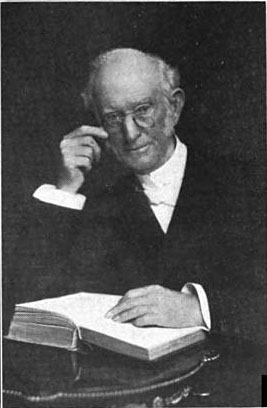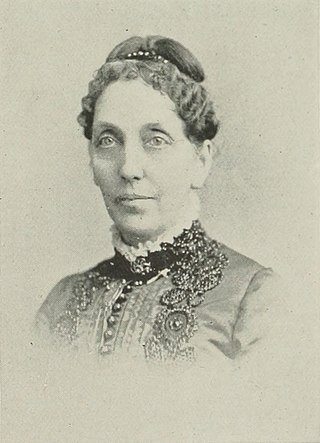Related Research Articles
Pilgrim Holiness Church (PHC) or International Apostolic Holiness Church (IAHC) is a Christian denomination associated with the holiness movement that split from the Methodist Episcopal Church through the efforts of Martin Wells Knapp in 1897. It was first organized in Cincinnati, Ohio, as the International Holiness Union and Prayer League (IHU/IAHC). Knapp, founder of the IAHC, ordained and his Worldwide Missions Board sent Charles and Lettie Cowman who had attended God's Bible School to Japan in December 1900. By the International Apostolic Holiness Churches Foreign Missionary Board and the co-board of the Revivalist the Cowmans had been appointed the General Superintendents and the Kilbournes the vice-General Superintendent for Korea, Japan and China December 29, 1905. The organization later became the Pilgrim Holiness Church in 1922, the majority of which merged with the Wesleyan Methodists in 1968 to form the Wesleyan Church.

William Fraser McDowell was an American bishop of the Methodist Episcopal Church, elected in 1904. He was born in Millersburg, Ohio, U.S.
Samuel Ross Hay was an American bishop of the Methodist Episcopal Church, South, elected in 1922.

The Wesley United Methodist Church in Austin, Texas, United States, was founded in 1865, at the end of the American Civil War. Its original members were Austin-area freedmen, and it remains a predominantly African-American congregation. On March 4, 1865, the Reverend Joseph Welch, Presiding Elder of the Texas District of the Mississippi Mission Conference of the Methodist Episcopal Church, presided over the meeting at which Wesley was founded. This historical meeting was held in the basement of the old Tenth Street M. E. Church, South in Austin, Texas.
The Methodist Mission was the Methodist Episcopal Church's 19th-century conversion efforts in the Pacific Northwest. Local Indigenous cultures were introduced to western culture and Christianity. Superintendent Jason Lee was the principal leader for almost a decade. It was a political and religious effort. Two years after the mission began, the church's Board of Foreign Missions described its intent to reclaim "these wandering savages, who are in a very degraded state, to the blessings of Christianity and civilized life." Alongside the missions founded in the region were several secular operations opened. These were maintained to allow for material independence from the Hudson's Bay Company (HBC), then the preeminent economic entity in the region among European descendants.

Hunter Corbett D.D. was a pioneer American missionary to Chefoo, Shandong China, he served with the American Presbyterian Mission. He was a fervent advocate of the missionary enterprise.

Robert Samuel Maclay, D.D. was an American missionary who made pioneer contributions to the Methodist Episcopal missions in China, Japan and Korea. He served as the first president of Aoyama Gakuin University.

Harry Frederick Ward Jr. was an English-born American Methodist minister and political activist who identified himself with the movement for Christian socialism, best remembered as first national chairman of the American Civil Liberties Union (ACLU) from its creation in 1920 until his resignation in protest of the organization's decision to bar communists in 1940.
Lloyd Stowell Shapley was a United States Navy Captain who served as the 32nd Naval Governor of Guam. Shapley served as governor from April 7, 1926, to June 11, 1929.

The Reverend Samuel Merrill Woodbridge, D.D., LL.D. was an American clergyman, theologian, author, and college professor. A graduate of New York University and the New Brunswick Theological Seminary, Woodbridge preached for sixteen years as a clergyman in the Reformed Church in America.

Mary Sparkes Wheeler was a British-born American author, poet, and lecturer. She wrote the lyrics to several hymns, including two well-known soldiers' decoration hymns. Her poems were set to music by Professor Sweeney, P. P. Bliss, Kirkpatrick and others. She was the author of Poems for the Fireside (1883), Modern Cosmogony and the Bible (1880), First decade of the Woman's Foreign Missionary Society of the Methodist Episcopal Church : with sketches of its missionaries (1883), As it is in Heaven (1906), and Consecration and purity, or, The will of God concerning me (1913).

Haven Institute and Conservatory of Music, also known simply as Haven Institute, was an American private historically black Methodist college active from 1865 until the early-1930s, located in Meridian, Mississippi. It was founded in 1865 by Moses Austin, a pastor of the Saint Paul Methodist Episcopal Church of Meridian and a formerly enslaved person. Originally it was called Meridian Academy and it was located at 27th Avenue and 13th Street in Waynesboro, Georgia, however the name changed in 1914 and the campus moved in 1921.
Central Alabama Institute was a school for African Americans in Alabama. It was established as Rust Normal Institute, a school to train African American teachers in Alabama in 1872. It opened in Huntsville, Alabama in 1878. It became Central Alabama Academy in 1890. In 1904 it moved to Mason City on the outskirts of Birmingham, Alabama. In 1922 its main building and other structures were struck by fire. It was not rebuilt or reopened. The school was affiliated with the Methodist Church.
Stowell is a surname, and may refer to:

The Protestant mission began in the Chinese province of Sichuan in 1877, when premises were rented by the China Inland Mission in Chungking. However, it grew rather slowly, it was not until the late 1980s that Protestantism experienced rapid growth. The two largest denominations in the province before 1949 were Anglicanism and Methodism.

James Monroe Buckley was a Methodist minister, doctor, author, and editor of the Christian Advocate.

The Canadian Methodist Mission (CMM), also known as Missionary Society of the Methodist Church in Canada, was a Canadian Methodist Christian missionary society mostly working in the province of Szechwan, which was also referred to as "West China."
The history of Methodism in Sichuan began in 1882 when missionaries began to arrive from the United States. Methodists founded or helped found several colleges, schools, and hospitals to aid in modernization and conversion efforts. Later, American Methodists were joined by missionaries from Canada. Methodism grew to become one of the two largest denominations of Protestant Christianity in the province by 1922, along with Anglicanism.
The history of Baptist Christianity in Sichuan began in 1890 when missionaries began arriving from the United States. Baptist missionaries in Sichuan were organized under the American Baptist Missionary Union, later renamed American Baptist Foreign Mission Society. Missionary activity in China generated controversy among many native Chinese and faced armed opposition during both the Boxer Rebellion and the later Communist movement in China. Although the former did not affect Sichuan so much as some other parts of China, the province was one of the hotbeds of anti-missionary riots throughout its ecclesiastical history.
References
- ↑ "Jay S. Stowell (Jay Samuel), 1883-1966". docsouth.unc.edu.
- ↑ "Rev. Jay Samuel Stowell". The Pensacola News . October 6, 1966. p. 2.
- ↑ "Jay Samuel Stowell, 83, Dies; Retired Church Aide and Author". The New York Times . October 7, 1966.
- ↑ "Rites conducted for Rev. Stowell". The Post-Standard . United Press International. October 8, 1966. p. 23.